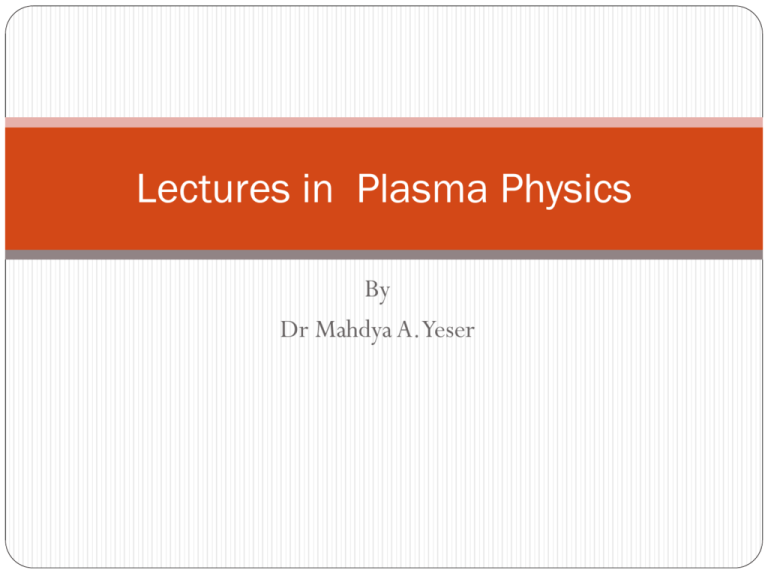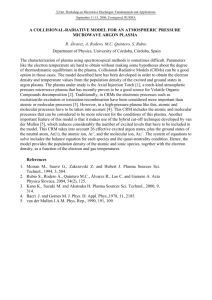Lectures in Plasma Physics
advertisement

Lectures in Plasma Physics By Dr Mahdya A.Yeser 1.1 Nature of Plasma As the temperature of a material is raised, its state changes from solid to liquid and then to gas. If the temperature is elevated further, an appreciable number of the gas atoms are ionized and a high temperature gaseous state is achieved, in which the charge numbers of ions and electrons are almost the same and charge neutrality is satisfied on a macroscopic scale. When the temperature of a gas is T(K), the average velocity of the thermal motion of a particle with mass m, that is, thermal velocity vT is given by where κ is the Boltzmann constant κ = 1.380 658(12) × 10−23 J/K and κT denotes the thermal energy. Therefore the unit of κT is the joule (J) in MKSA units. In many fields of physics, the electron volt (eV) is frequently used as the unit of energy. This is the energy required to move an e lectron, charge e = 1.602 177 33(49)×10^−19 coulomb, against a potential difference of 1 volt: 1 eV = 1.602 177 33(49) × 10^−19 J . The temperature corresponding to a thermal energy of 1 eV is 1.16 × 10^4 K (= e/κ). The ionization energy of the hydrogen atom is 13.6 eV. Even if the thermal energy (average energy) of hydrogen gas is 1 eV, that is T ∼ 104 K, there exists a small number of electrons with energy higher than 13.6 eV, which ionize the gas to a hydrogen plasma. We can defined the plasma as: Plasmas are found in nature in various forms (see Fig. 1.1). Fig. 1.1.Various plasma domains in the n–κT diagram One example is the Earth’s ionosphere at altitudes of 70– 500 km, with density n ∼ 10^12 m^−3 and κT ≈ 0.2 eV. Another is the solar wind, a plasma flow originating from the sun, with n ∼ 10^6–10^7 m^−3 and κT ≈ 10 eV. The sun’s corona extending around our star has density ∼ 10^14 m^−3 and electron temperature ∼ 100 eV, although these values are position-dependent. The white dwarf, the final state of stellar evolution, has an electron density of 10^35– 10^36 m−3.Various plasma domains in the diagram of electron density n(m−3) and electron temperature κT (eV) are shown in Fig. 1.1. Active research in plasma physics has been motivated by the aim to create and confine hot plasmas in fusion research. In space physics and astrophysics, plasmas play important roles in studies of pulsars radiating microwaves or solar X-ray sources. Another plasma physics is the study of the Earth’s environment in space Practical applications of plasma physics are MHD (magneto hydrodynamic) energy conversion for electric power generation and ion rocket engines for spacecraft. Plasma processes for the manufacture of integrated circuits have attracted much attention recently 1.3Charge Neutrality and Landau Damping One fundamental property of plasmas is charge neutrality. Plasmas shield electric potentials applied to the plasma. When a probe is inserted into a plasma and a positive (negative) potential is applied, the probe attracts (repels) electrons and the plasma tends to shield the electric disturbance. Let us estimate the shielding length. Assume that heavy ions have uniform density (ni = n0) and that there is a small perturbation in the electron density ne and potential φ. Since the electrons are in the Boltzmann distribution with electron temperature Te, the electron density ne becomes ………….(1.3) where φ is the electrostatic potential and is assumed.The equation for the electrostatic potential comes from Maxwell’s equations : E = −∇φ then we can take the last eq. at where Definition of plasma: The forth state of matter ,a quasineutral gas of charged and neutral particles which exhibits collective behavior. The plasma conditions : 123- Ch (2) Plasma Characteristics 2.1 Velocity Space Distribution Function vx vy dvz dvy vz dvx How 3.3 Equation of Motion of a Charged Particle 4 Velocity Space Distribution Function and Boltzmann’s Equation 4.1 Phase Space and Distribution Function 4.2 Boltzmann’s Equation and Vlasov’s Equation







